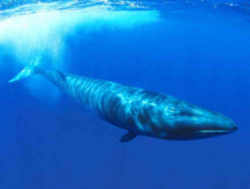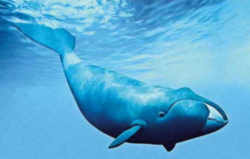Alaska State Marine Mammal
Bowhead Whale

(Balaena mysticetus)
Adopted in 1983.
The Bowhead whale, (Balaena mysticetus,) per the 13th Legislature was adopted in 1983 as the state marine mammal of Alaska. Bowheads are making a slow and precarious recovery after being hunted nearly to extinction. The bowhead whale is classified as endangered and has been protected by the International Whaling Commission since 1937. This large whale with thick blubber is still very important to Eskimo subsistence hunters and coastal villages in Alaska. There are an estimated 8,000 bowhead whales in existence today.
Alaska State Marine Mammal: Bowhead Whale

This robust and powerful baleen whale measures up to 18 meters in length and weighs about 3.3 tons per meter (60 feet long, one ton per foot). When it surfaces to breathe a V-shaped spout issues from twin blowholes at the peak of its massive head, a head that is powerful enough to break through a foot of sea ice. In the days of commercial whaling the bowhead was valued for its large quantities of baleen and oil.
Bowheads spend their lives near sea ice margins. Once found throughout northern polar waters, they are reduced to one substantial population inhabiting Beringia and remnants in the eastern Canadian Arctic and the Sea of Okhotsk. The Beringian bowheads winter in the Bering Sea. In spring they migrate north through open ice leads, usually rounding Point Barrow by early June on their way to summer feeding areas in the Canadian waters of the eastern Beaufort Sea. In August they begin moving west toward Wrangel Island, and in late fall return south through Bering Strait.
Bowheads evidently sense their surroundings mainly by sound, which travels five times faster and much farther in water than in air. Sounds produced
by the environment or by the whales reverberate differently under different ice conditions. Bowheads are excellent navigators of ice-choked waters,
although they sometimes get trapped by ice and drown. Bowheads make a wide variety of sounds with a voice covering seven octaves. Like humpbacks, they
may "sing" in deep undulating tones, often with two notes at once. During migration they evidently call not only to help navigate but also to maintain
cohesion of small herds dispersed over perhaps a half dozen square miles.
Bowheads feed primarily during summer on planktonic animals generally less than an inch long. After scooping up a huge quantity of food and water, they force the water back out of their mouths through a baleen strainer. It is believed that arctic species feed mostly in summer. Whales build up blubber reserves that maintain them during winter, which may be a time of fasting.
Females probably become sexually mature at 10 to 15 years of age, there after giving birth every three to four years. A single calf is born during spring migration following a pregnancy of about one year.
Other than people, the bowheads' only natural enemies are killer whales (Orcas). When threatened the unaggressive bowhead dives and, when possible, retreats under the ice.
Alaska Statute
The law designating the bowhead whale as the official Alaska state marine mammal is found in the 2004 Alaska Statutes, specifically Title 44 (State Government), Chapter 09 (State Seal, Flag, and Emblems), Section 075 (State Marine Mammal.).
Alaska Statutes.
Title 44. State Government
Chapter 9. State Seal, Flag, and Emblems
Section 75. State Marine Mammal.
AS 44.09.075. State Marine Mammal.
The bowhead whale is the state marine mammal.
Taxonomic Hierarchy: Bowhead Whale
Kingdom: AnimaliaPhylum: Chordata
Class: Mammalia
Order: Cetacea
Suborder: Mysticeti
Family: Balaenidae
Genus: Balaena - Linnaeus, 1758
Species: B. mysticetus








